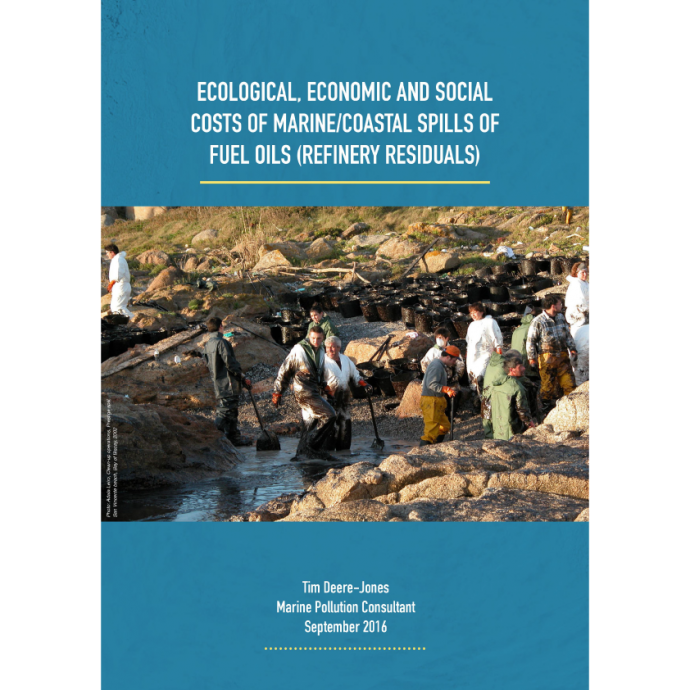Ecological, economic and social costs of marine/coastal spills of fuel oils (refinery residuals)
For several centuries Northern hemisphere maritime trading nations have dreamed of, and struggled to discover, sea routes through the Arctic ocean in order to generate greater connectivity, and shorter, cheaper journeys, between the trading ports of Europe, north America, Asia and Russia. Such dreams have been thwarted, by both seasonal and permanent icing of the polar seas, and the major difficulties of navigating sub-polar seas in the context of icebergs and extreme weather conditions.
There is now, however, a broad scientific consensus that both permanent and seasonal sea ice cover in polar and sub-polar seas are steadily reducing in response to climate change. This factor, coupled with the growing demands of maritime trade for shorter, quicker and less expensive sea routes around the northern hemisphere is generating a significant increase in vessel traffic through Arctic and sub-polar seas.
In 2009, the Arctic Council’s Arctic Marine Shipping Assessment report estimated that approximately 3,000 ships operated in truly Arctic waters, while another 3,000 were annually using the North Pacific Great Circle Route, roughly adjacent to the Aleutian and Kuril islands. The report stated that: “natural resource development and regional trade are the key drivers of increased Arctic marine activity.” Thus it is no surprise that fishing vessels, oil/gas/mineral carriers, community supply ships and cruise ships represent the bulk of such traffic through the Arctic and sub-polar seas.
In September of 2009, two German cargo ships completed the first commercial passage from South Korea to the Netherlands via the Northern Sea Route, along the Arctic north coast of Russia. This route is generally considered less difficult than the North West Passage, which transits through the Canadian Arctic Archipelago.
According to a 2014 report issued by the Arctic Institute (a Washington based think tank) 71 ships carried 1.35 million tons of goods through the Northern Sea Route route in 2013. That was up from 46 vessels with 1.26 million tons of cargo in 2012. In total, 41 vessels traveled the full length of the Arctic shipping lane (Asia to Europe), and of those, 30 ships carried cargo, the report said. Most of the remainder of the new traffic through the Northern Sea Route was one-way shipments of fossil fuels from Northern Europe to Asia, or was between Russian ports.
Since the first crossing of the North West Passage by Amundsen in 1906, on average, less than 1 ship every ten years had completed the full passage until 1969, when the oil tanker SS Manhattan, refitted with an ice-breaker bow, crossed the Passage from east to west, and then returned east. That trip resulted in ten transits being recorded that summer, as four icebreakers escorted the oil tanker. The number of completed trips through the Arctic Ocean increased in the late 1970s, mostly due to the availability of icebreakers and other ships capable of navigating in difficult northern waters.
A record number of vessels (30) transited the North West Passage in 2012. In 2013, for the first time, a large bulk carrier (coal) transited the North West Passage. Only 17 vessels managed the full North West Passage in 2014, due to a short and cold summer.
In 2014, in the context of increasing traffic volume in what are considered to be some of the most significant high risk areas for global shipping, the International Maritime Organization (IMO) adopted the Polar Code. The Polar Code is widely regarded as a positive step towards protection of polar marine environments and will enter into force on January 1st 2017. However there is an emerging body of concern that the Code has failed to address the fact that refinery residual fuel oil spills (Heavy Fuel Oils [HFO] and Medium Fuel Oils [MFO]) are widely identified as the major risk posed by shipping to Arctic environments and wildlife and that, although fuel oil use and carriage in the Antarctic has been banned, those same fuels are permitted in the Arctic.
This report offers a brief review of the behavior and fate of both HFO and MFO spills in polar, sub-polar and similar cold water marine environments. The report also offers a brief review of the impacts of such spills and the relative “costing” of some of the impact parameters of such spills.
About the author:
Tim Deere-Jones is a graduate of Cardiff University’s Department of Maritime Studies. He has been working as an independant marine pollution researcher and consultant since the mid 1980s for a broad range of global clients. Tim has worked intensively on some of Europe’s major marine oil spills and has specific experiance and a particular interest in marine pollution issues relating to the long term fate and behaviour of Heavy and Medium Fuel Oils and Crudes in marine, coastal, estuarine and coastal zone (terrestrial) environments.

